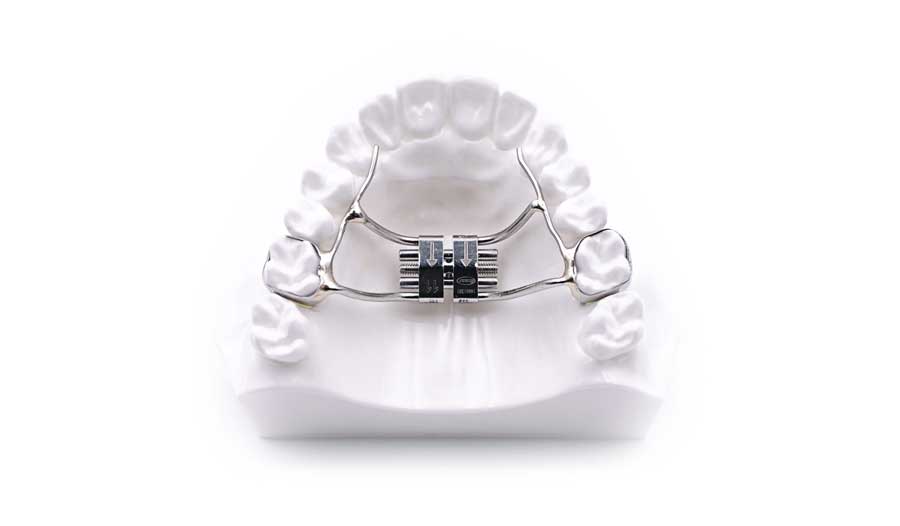Here, we’ll tell you everything you need to know about them.
A palate expander is an orthodontic appliance designed to widen the upper jaw (maxilla). It is mainly used for correcting the posterior dental cross bite, relieving dental crowding, widening the smile arc, and widening the floor of the nasal cavity to improve the nasal airflow. Palate expander can be used on its own, or in combination with other orthodontic appliances such as Braces, Functional Appliances, or Headgears. There are two types of palatal expanders – fixed expander (glued to teeth), and removable expander. Each type has its own indications, advantages and disadvantages. Your Orthodontist will choose the type that is most suitable for you or your child. All palate expanders are custom-made. They are either made from impression taken from the mouth, or digital scan taken from the mouth.
Palatal expanders do not work as well for adults when compared to children or adolescents. This is because the sutures surrounding the upper jaw (maxilla) fuses and calcifies as a child grows older. Once the sutures are fused and completely calcified, the upper jaw can no longer be expanded. Therefore, if there is an indication for upper jaw expansion, it is best to have palate expander treatment early. The most common age for palate expander treatment is from 8 to 15 years of age. For adult treatment, if the amount of expansion is small, then palatal expander may work. If the amount of expansion is significant (such as correction of posterior crossbite), then palate expander combined with jaw surgery will be required.

If there is an upper and lower jaw size discrepancy, then palate expander treatment is necessary. Narrow upper jaw can cause lasting bite problems and can impact physical appearance. Because of this, school dentists, children dentists, and family dentists are trained to identify signs of narrow upper jaw early so a prompt referral can be made to an Orthodontist. Once the diagnosis of narrow upper jaw has been confirmed, Orthodontists will strongly advise upper palatal expander treatment — especially in children or young adolescents. As previously noted, the application for palate expanders becomes more difficult the older you get, so it’s best to get started right away.
Depending on the type of palate expander used and the severity of the problem, the palatal expander treatment can range from three months to twelve months. Like any orthodontic treatment, once the expander is removed, your Orthodontist may recommend wearing a retainer to maintain the expansion until the upper jaw expansion has stabilized.
Expansion of your upper jaw can positively impact your life in a number of ways, and not all are aesthetic.
Some common results include:
- Correcting posterior dental crossbite
- Correcting overbite and underbite (in combination with other orthodontic appliances)
- Relief of mild to moderate dental crowding
- Widening of the smile arc
- Improving airflow through nasal cavity

Because your mouth is getting used to a foreign object, there may be some initial side effects after installing a palatal expander. If you get any of the side-effects below, don’t worry — they’re normal and only temporary.
-
Extra saliva: The expander will cause your mouth to produce more saliva, which will take a day or two to get used to.
- Inhibited speaking: Naturally, your speaking will be slightly affected by the installation of the expander. Just like the saliva, you’ll have conquered this in a few days.
- Excess food debris: Like your teeth, the expander is another place where food can build up. It’s common for this to happen between the expander and the roof of the mouth. Combat this with diligent dental hygiene.
- Gap tooth: Expanding the jaw can open up spaces between your upper front teeth. However, you’ll only have this quirk for a short while, as the gap will start to close naturally before the treatment is over.
- Discomfort: like any orthodontic appliance, there will be short term discomfort after installing the palate expander. This can be irritation to cheeks and tongue, sensitive teeth, mild toothache, or mild jaw joint ache. The discomfort will disappear in a week or two once you get used to the palatal expander.
While an expander is usually done before braces, it’s possible that you could have both at the same time. It’s also perfectly safe. Your orthodontist will be simultaneously correcting jaw discrepancy and teeth alignment and having both at the same time in some cases could save the total treatment time.

Palate expander will not make your face wider. However, if you have a facial asymmetry associated with posterior dental cross bite, then palatal expander can improve your facial asymmetry. Expanding the maxilla will correct your jaw to the way it was meant to be, and have it looking the way it was meant to look.
The best place to start is by getting in touch with your local orthodontist using our finder. They’ll be happy to give personalised advice on any of the above topics.
For more on braces, read about how to care for them, how to survive special occasions wearing them, and our five life hacks for living with them.









